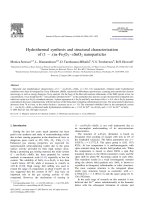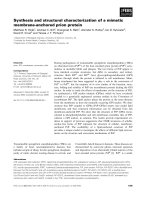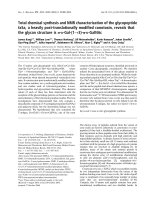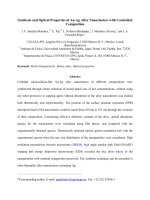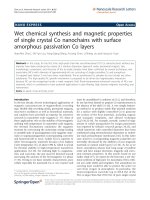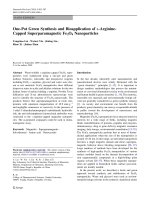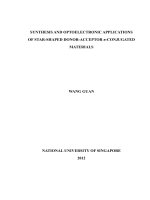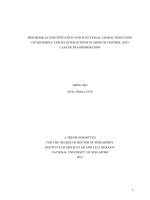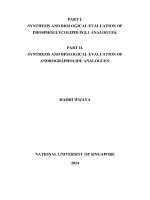Green synthesis and chemometric characterization of hydrophobic xanthan matrices: Interactions with phenolic compounds
Bạn đang xem bản rút gọn của tài liệu. Xem và tải ngay bản đầy đủ của tài liệu tại đây (2.71 MB, 10 trang )
Carbohydrate Polymers 288 (2022) 119387
Contents lists available at ScienceDirect
Carbohydrate Polymers
journal homepage: www.elsevier.com/locate/carbpol
Green synthesis and chemometric characterization of hydrophobic xanthan
matrices: Interactions with phenolic compounds
´n Isasi *
Max Petitjean , Nerea Lamberto , Arantza Zornoza , Jos´e Ramo
Department of Chemistry, University of Navarra, 31080 Pamplona, Spain
A R T I C L E I N F O
A B S T R A C T
Keywords:
Cyclodextrins
Xanthan gum
Principal component analysis
Lignin
Locust bean gum
Chitosan
Polysaccharides such as xanthan, locust bean gum or chitosan are easily crosslinked and purified using citric acid
in an ecofriendly process. In order to achieve an improved sorption capability towards hydrophobic solutes,
β-cyclodextrin, a cyclic oligosaccharide, and lignin, a natural aromatic polymer, are incorporated in the same
process. Once crosslinked, the influence of these on the sorption capacities towards model solutes has been
assessed by comparing the sorption isotherms of matrices with or without the hydrophobic modifications. The
sorption capacities of these materials for different phenolic compounds have also been tested to ascertain their
efficiencies as a function of their affinities to β-cyclodextrin cavities and/or their partition coefficients. In
addition, these functionalized carbohydrate matrices were successfully characterized by principal component
analysis, which is a useful tool to select the most appropriate polymers to interact with a specific molecule.
1. Introduction
The design of novel materials needs to become as ‘green’ as possible
in order to prevent further pollution of the planet. The use of biomass
raw materials is therefore advisable, provided that their physicochemical properties are appropriate, because of their biodegradability.
In the last decades, the trends in environmental engineering are
shifting towards the development of sustainable and eco-friendly tech
nologies for waste water treatment. Their advantages are undoubted
with respect to those aspects. Non-conventional green adsorbents
include industrial by-products, agro-food wastes, natural products (such
as clays, hemp, flax, and cotton), and biological materials including
plants, algae, and biopolymers (Gr´egorio Crini et al., 2018). In partic
ular, when compared to conventional activated carbons and synthetic
ion-exchange resins, polysaccharide-based adsorbents offer advantages
in cost, versatility, efficiency, selectivity, and regeneration (Oladoja
et al., 2017). In addition to their uses in water treatment processes, the
design of green sorbents presents other possibilities in the agro-food
sector: valorization of residues and formulation of safer controlledrelease agrochemicals, for instance (Campos et al., 2014).
Many natural polysaccharides, coming from bacterial, animal or
vegetal origins, possess interesting characteristics as hydrogels and can
be employed for sorption and/or delivery processes when used by
themselves or combined through crosslinking reactions. In particular,
citric acid is a sustainable triacid allowing, by means of a low energy
reaction, the crosslinking of any polysaccharides by facile esterification
reactions (Awadhiya et al., 2016; Bueno et al., 2013; Salihu et al., 2021).
The hydrophilic nature of polysaccharide-based adsorbents, swel
lable in water and allowing a fast diffusion of the target molecules, are
advantageous when compared to the performance of synthetic resins
and activated carbons. The addition of hydrophobic moieties to the
crosslinked polysaccharide gels will provide them with the amphiphilic
character required to efficiently trap non-polar pollutants. Cyclodextrin
and lignin will be the hydrophobic modifiers tested and compared in this
investigation.
Cyclodextrins are a family of natural cyclic oligosaccharides, mainly
composed of 6, 7 or 8 glucose unit molecules (known as α-, β- and
γ-cyclodextrin, respectively). Their cyclic configuration creates a hy
drophobic core, allowing complexation with certain hydrophobic mol
ecules and moieties. Their saccharide composition confers them, at the
same time, a hydrophilic character and the possibility of a facile cross
linking thanks to their hydroxyl groups. Thus, it is also feasible to pre
pare cyclodextrin polymers in the presence of an appropriate
crosslinker. Cyclodextrins can constitute the basic unimer to produce a
nanosponge (Caldera et al., 2017), but also a grafted adjuvant, to create
novel materials with a new functionality (Medronho et al., 2013). These
products could be used in the medical sector, food technologies (Petit
jean, García-Zubiri, & Isasi, 2020) or water decontamination processes
* Corresponding author.
E-mail address: (J.R. Isasi).
/>Received 25 September 2021; Received in revised form 10 March 2022; Accepted 18 March 2022
Available online 23 March 2022
0144-8617/© 2022 The Authors. Published by Elsevier Ltd. This is an open access article under the CC BY-NC-ND license ( />
M. Petitjean et al.
Carbohydrate Polymers 288 (2022) 119387
(Gr´egorio Crini, 2021).
Lignin is a heterogeneous aromatic biopolymer, the second most
abundant in the plant kingdom. This macromolecule possesses a threedimensional structure, average masses of about 10,000 Da, and a wide
diversity of chemical groups (phenolic, hydroxyl, methoxy, …). It is
mainly composed of three types of blocks: p-hydroxyphenyl, guaiacyl
and syringyl units linked with different junctions (Xu & Ferdosian,
2017). Due to its natural origin, biodegradability and physico-chemical
properties, it is used for medical applications such as wound dressing or
drug delivery (Spiridon, 2020), but also for renewable energy usages
(Espinoza-Acosta et al., 2018) and environmental purposes as a heavy
metal sorbent (Ge & Li, 2018) or for dye removal (Domínguez-Robles
et al., 2018). The Kraft process, used to separate lignin from wood using
sodium sulfide in basic media, is the largest source of technical lignin
(Wickham et al., 2019). Besides the modification of lignin by adding
certain functionalities to its structure, other biopolymers such as starch
(Shi & Li, 2016), chitosan (Crouvisier-Urion et al., 2019) and xanthan
(Raschip et al., 2013) have been used as starting structures to create
novel materials by mixing/crosslinking them with lignin.
In two previous works, we have prepared green sorbents using nat
ural building blocks and solventless procedures: different hydrophilic
polysaccharide matrices were functionalized with cyclodextrin to
incorporate the hydrophobic cavities suitable to entrap molecules of
interest (Petitjean, Aussant, et al., 2020; Petitjean & Isasi, 2021). Our
first work was aimed to find the most suitable (low-cost, green and
facile) conditions to prepare the matrices. In our second step, we found
remarkable differences with regard to the influence of the poly
saccharide matrices in the mechanisms of the interaction with certain
model molecules. We selected three polysaccharides for the first part of
this study: xanthan, locust bean gum, and chitosan, due to their diverse
structures and properties.
Xanthan is a branched polysaccharide produced by Xanthomonas
campestris bacteria. Its main chain is composed of D-glucose, substituted
every two units with a glucuronic acid moiety between two mannoses,
the last one finishing with a pyruvate function (García-Ochoa et al.,
2000). Locust bean gum is also a natural branched polysaccharide,
extracted from the seed of the carob fruit, and composed of a skeleton of
mannose units with a galactose branch every four units. The aqueous
solutions of these two polysaccharides present interesting rheological
properties for food or medical purposes (Barak & Mudgil, 2014). Chi
tosan is a derivative from chitin, a natural polysaccharide obtained from
exoskeleton of Crustacea. This linear copolymer is composed of
glucosamine and N-acetyl-glucosamine units. Its antibacterial proper
ties, as well as its bioactivity and biocompatibility make it usable in the
biomedical field, but also in other sectors such as the textile industry and
environmental chemistry (Morin-Crini et al., 2019).
As mentioned above, the efficiency and mechanisms of the sorption
process were investigated by using a single model molecule. Neverthe
less, the tailoring of novel green sorbents is one of their most interesting
features, so their efficient performance with respect to a model sorbate is
not sufficient to ascertain their potential. In addition, cyclodextrins are
not the only hydrophobic green modifiers of interest. In the present
investigation, we hypothesize that cyclodextrin and lignin hydrophobic
functionalizations using natural building blocks by means of a solvent
less procedure will also produce useful sorbents to entrap phenolic
compounds. The selection of this family of chemicals is due to two
reasons: the interest of polyphenols as bioactive compounds is undis
puted and, on the other hand, many water pollutants also belong to this
group. The insights into the mechanisms of the interactions will be
studied by testing the affinity of these matrices towards twenty phenolic
compounds using principal component analysis and other chemometric
procedures in order to relate molecular properties of the sorbates with
their corresponding sorption capacities in the different carbohydrate
matrices.
2. Experimental section
2.1. Materials
Kraft lignin (BioPiva 190, UPM, mol. wt. of 5000 Da), β-cyclodextrin
(Wacker, humidity 12.5%), xanthan gum (Sigma Aldrich, lot
SLBG3388V), locust bean gum (Sigma Aldrich, lot SLBC7065V), chito
san (deacetylation degree of 90% measured by NMR-1H in D2O with 2%
HCl, Bruker Advance 400 MHz), citric acid (Panreac AppliChem) and
dibasic sodium phosphate (Na2HPO4 ≥ 98%) were used as received to
prepare the crosslinked resins. The characterization data of the lignin
sample (Dastpak et al., 2020) and the polysaccharides used in this work
can be found in the Supplementary Data section (Table S1 and Fig. S1).
Sorption analyses were performed with phenolphthalein (Merck,
99%) and 19 other aromatic compounds (see Table 1).
2.2. Methods
2.2.1. Synthesis procedure
The polysaccharide matrices were prepared by mixing the raw ma
terials, namely, citric acid as a crosslinker (1.30 g), sodium phosphate
dibasic as a catalyst (0.28 g), a selected polysaccharide (2.87 g) or a 1:1
(w/w) polysaccharide/β-cyclodextrin mixture, plus Kraft lignin (0.50 g),
in a mortar (see Scheme 1 and Table S2), crushing them together to
disperse them into a uniform powder and crosslink them thermally at
170 ◦ C for 45 min (Memmert UN-30 oven). In this design, β-cyclodex
trin, which is a carbohydrate (with its unique hydrophobic complexa
tion capabilities), has been considered as a replacement of the other
polysaccharides while lignin is a modifier of the crosslinked networks (i.
e. a hydrophobic additive). A first washing with water (100 mL) is
carried out to separate the insoluble and soluble fractions (the latter
studied by size exclusion chromatography, see below). After this filtra
tion, a second rinsing of the insoluble solid is performed using an
acetone/water mixture (70/30, v/v, 100 mL) to solubilize and wash
away the unreacted Kraft lignin. Finally, a third washing with water
(100 mL) allows us to eliminate the last residues (including acetone from
the previous step) present in the matrices. The insoluble fractions are
then heated up to 102 ◦ C during 24 h to eliminate the humidity and
pulverized using a Retsch MM300 ball mill for 30 s (some micrographs
are shown in the Supplementary Data section). Final yields are calcu
lated by weighing the mass of the dried final products.
Nomenclature: the abbreviations used for the matrices produced in
this work include the letters “L” and “β”, to indicate lignin and
β-cyclodextrin functionalizations, respectively, followed by “c”,
Table 1
Aromatic compounds used in this work, code numbers, abbreviations and
sources (see other properties in the Supplementary data section, Table S1A).
2
Code number
Name
Abbreviation
Source, purity
1
2
3
4
5
6
7
8
9
10
11
12
13
14
15
16
17
18
19
3-Nitrophenol
4-Nitrophenol
Guaiacol
4-Ethylguaiacol
Phenol
4-Ethylphenol
1-Naphthol
Caffeine
Caffeic acid
Salicylic acid
meta-Cresol
ortho-Cresol
para-Cresol
Methylparaben
Ethylparaben
Propylparaben
Eugenol
Tyrosol
Vanillin
3nPh
4nPh
Gua
4etGua
Ph
4etPh
1-NOH/1-N
Caff
CaffAc
SalAc
mCr
oCr
pCr
metPHB
etPHB
prPHB
Eug
Tyr
Van
Sigma (China), 99%
Sigma (India), 99%
Sigma (USA)
Sigma (China), 98%
Panreac (Spain), 99.5%
Sigma (China), 99%
Merck (Germany), 99%
Guinama (Spain), 99.7%
Sigma (China), 98%
Panreac (Spain), 99.5%
Sigma (Germany), 99%
Sigma (Germany), 99%
Sigma (USA), 99%
Sigma (USA)
Sigma (USA)
Sigma (USA)
Sigma (Germany), 99%
Sigma (USA), 98%
Panreac (Spain), 99%
M. Petitjean et al.
Carbohydrate Polymers 288 (2022) 119387
Scheme 1. Synthesis procedure of the insoluble crosslinked matrices.
symbolizing the citric acid crosslinker (common to all samples), plus a
last uppercase letter corresponding to the polysaccharides: “X” for
xanthan, “G” for locust bean gum, and “C” for chitosan (see Tables 2 and
S2).
fractions recovered are concentrated with a rotary evaporator Büchi R200. To analyze the reaction and washing processes, a Waters 600
Controller device was employed, attached to a Waters 2414 refractive
index detector and Waters 996 photodiode array detector, and an
autosampler Waters 717 Plus. The column employed was a TSK-Gel
Alpha 5000 (Tosoh Bioscience) calibrated with polyethylene oxide
standards, and the flow rate was 1 mL/min.
Carbonyl and lignin contents by infrared spectroscopy. The insoluble
crosslinked matrices were analyzed using a Shimadzu IRAffinity-1S in
strument coupled with a Golden Gate™ attenuated total reflectance
2.2.2. Characterization of the matrices
Dialysis of soluble byproducts and size exclusion chromatography (SEC).
The water soluble byproducts were collected and dialyzed through
Spectra/Por cellulosic membranes (MWCO 6-8000, Spectrum Labs) in 1
L of distilled water during 24 h (twice). The internal and external
Table 2
Characterization of citrate crosslinked (c) polysaccharide (X: xanthan, G: locust bean gum, C: chitosan) matrices functionalized with lignin (L) and β-cyclodextrin (β).
Matrix
CDeqa
%ligb
− COOHc
Carbox.d
%CTRe
q1-N 2f
q1-N 20f
q1-N 200f
βc
Lβc
βcX
LβcX
cX
LcX
βcG
LβcG
cG
LcG
βcC
LβcC
cC
LcC
16.5
40.6
12.7
33.6
0.0
8.3
19.2
30.1
0.0
2.1
17.8
30.6
0.0
0.8
0.0
10.4
0.0
8.2
0.0
6.0
0.0
9.2
0.0
7.6
0.0
11.0
0.0
9.0
18.7
21.2
17.5
20.3
14.0
20.7
19.6
18.1
17.0
12.6
17.9
9.6
13.0
8.7
32.6
55.2
25.6
44.8
14.3
39.4
35.0
29.3
21.2
36.8
27.8
28.1
14.1
37.8
46.2
43.3
35.9
35.1
33.4
27.7
37.8
36.4
46.4
31.6
35.0
37.4
37.0
39.0
0.26
0.36
0.17
0.43
0.06
0.16
0.09
0.26
0.14
0.22
0.13
0.29
0.03
0.16
2.60
3.82
2.28
3.02
0.66
1.62
1.05
2.44
1.51
2.06
2.20
2.39
0.64
1.13
21.13
24.66
13.72
19.76
17.96
13.29
11.20
17.35
22.62
13.28
10.12
15.86
7.24
10.54
a
b
c
d
e
f
*
Amount of “equivalent-available” β-cyclodextrin cavities (mg CD per g) measured using phenolphthalein (n = 3, see Table S5 for standard deviations).
Amount of lignin (%) as obtained by FTIR using physical mixtures for calibration.
*Contents of carboxylic acid groups (mmol per 100 g) in the matrices obtained from TBO experiments.
*Carboxyl content (mmol per 100 g) after saponification measured by titration.
Percent of carbonyl groups as measured by the ratio of 1710 cm− 1, and 1710 cm− 1 plus 1010 cm− 1 bands.
Sorption capacity (mg/g) of 1-naphthol using 2, 20 and 200 mg/L as initial concentrations, respectively.
The degree (%) of esterification (%COOR) can be calculated from c and d using Eq. (2).
3
M. Petitjean et al.
Carbohydrate Polymers 288 (2022) 119387
(ATR) accessory device (Specac). The infrared spectra acquired were the
average of 32 scans between 4000 and 600 cm− 1 with a resolution of 4
cm− 1. The ratio of the intensity of the 1710 cm− 1 band (corresponding to
the citrate groups) and the sum of the intensities of that plus the one at
1010 cm− 1 (which gives an idea of the total sugar contents) was
calculated for each sample (Petitjean & Isasi, 2021). In the case of lignin,
the peak located at ca. 1520 cm− 1 was analyzed in physical mixtures of
the crosslinked polysaccharides with lignin to obtain a calibration curve
(see below).
Sorption analysis using liquid chromatography. For the phenolic com
pounds absorption studies, the high-pressure liquid chromatography
(HPLC) system used was an Agilent 1100 instrument, with C18 Luna
Phenomenex thermostated (40 ◦ C) column. The flow rate was set at 1
mL/min and a gradient mode was used for the mobile phase (up to 25
min): acetonitrile from 25% to 40%, H2O from 65% to 50%, plus
methanol 10%. For the two acidic phenolic compounds, the flow rate
was the same, but the mobile phase was prepared with 28% MeOH, 69%
H2O and 3% acetic acid. Four samples of each matrix (between 2 and 20
mg) were placed in 10 mL of a solution containing 20 ppm of the
phenolic compounds stirred at room temperature for 5 h. Then, the so
lutions were filtered through 0.1 μm PVDF membranes (Durapore ®)
and analyzed (see Supplementary Data for the standard deviations of
these determinations).
‘Available cyclodextrin’ and carboxylic contents. Two colorimetric
procedures were followed to obtain the amount of available cyclodextrin
moieties of the matrices and to quantify the carboxylic acid contents of
the samples. A 3.6 × 10− 5 mol/L phenolphthalein (previously mixed
with 0.4 mL of ethanol/L) solution is dissolved in a pH 10.5 buffer soư
ăkelă
lution (0.1 mol/L NaHCO3; 6 mol/L NaOH) (Ma
a et al., 1987). For
each polymeric matrix, samples were measured in triplicate using
different weights (2, 5 and 10 mg) in 7 mL of the aforementioned so
lution (see also Supplementary Data section). After 24 h, the samples are
centrifuged during 5 min at 10,000 rpm. Phenolphthalein absorption is
measured in the supernatants using an Agilent Technologies Cary 8454
UV–Vis device, equipped with an Agilent ChemStation software.
Carboxylic acid groups. The carboxyl groups characterization was
inspired by the method used by Blanchemain et al. (Blanchemain et al.,
2011) but it was not possible to filtrate our powder samples to perform a
desorption as suggested there. Instead, a solution of 0.2 g/L toluidine
blue (TBO) was prepared in pH 10 buffer and introduced in 15 mL flasks
containing 2 mg of the sample. After 24 h under mechanical agitation,
the samples were centrifuged during 10 min at 4400 rpm. Supernatants
were then measured at λ = 634 nm. The COOH amount in the matrix was
calculated assuming the 1:1 complexation of TBO.
Carboxyl contents by titration. 50 mg of matrix were dissolved in 0.1 N
NaOH (pH 12.5) during 4 h. The NaOH excess is then titrated with 0.5 N
HCl in a Hach autotitrator (Titralab AT1000). The carboxyl content
(mmol per 100 g) is then calculated following:
Carboxyl content (˝titr.˝) =
(Vb − Va )*N
*100
W
the remaining 1-naphthol is measured by HPLC (García-Zubiri et al.,
2007). The sorption model selected is Redlich-Peterson's (RP):
qe =
titr. − COOH(TBO)
*100
titr.
(3)
where qe is the amount of adsorbate in the adsorbent at equilibrium
(mg/g), Ce is equilibrium concentration (mg/L), KR (L/g) and aR (1/mg)
are the RP constants, and θ is the RP isotherm exponent.
Chemometric characterization by principal component analysis (PCA).
OriginPro (2016) software was used to obtain the biplot representation
(scores and loading vectors) to characterize the matrices and their in
teractions with the phenolic compounds. (Tables S3 and S4 include
values of the loadings obtained in the corresponding analyses.)
Additional characterization data of the sorbents. Some additional
characterization with regard to thermal stability, morphology and hy
drophilicity of the samples can be found in the Supplementary Data
section (thermogravimetric analysis, scanning electron microscopy,
swelling capacities).
3. Results and discussion
3.1. Synthesis and infrared characterization of lignin functionalized
polysaccharides
The first aim of the present investigation is to produce hydrophobi
cally modified polysaccharide matrices covalently crosslinked by means
of a facile and sustainable procedure. As seen in our previous studies on
the solventless crosslinking of polysaccharides and β-cyclodextrin using
citric acid (Petitjean, Aussant, et al., 2020; Petitjean & Isasi, 2021), the
yields are lower for mixtures with lower β-cyclodextrin ratios. Citric acid
reacts more efficiently with the long polysaccharide chains than with
β-cyclodextrin in these solid phase reactions. Accordingly, when lignin is
added to the reactive mixture, the situation becomes similar: the
β-cyclodextrin/lignin crosslinking process has the lowest yield (40%);
the insoluble fraction achieved for those matrices prepared with locust
bean gum, chitosan or xanthan gum reach considerably higher values
(up to 95% for LcX, see Fig. S2). Interestingly, for those matrices pre
pared with lignin, the process is even more efficient than when this
ingredient is not present in the mixture, which points to a favorable
crosslinking at the reaction conditions. The selection of such reaction
temperature and catalyst was based on the optimization of the process in
our previous work (Petitjean, Aussant, et al., 2020). It was observed
that, using a reaction temperature of 170 ◦ C, reaction times of 45 min
produced the highest yields, which remained constant for longer times.
As for the purification process, water is not enough to wash off all the
unreacted materials and soluble byproducts because of the presence of
lignin. The solubility of Kraft lignin is highest for a 70:30 acetone/water
mixture (Ajao et al., 2019), so this additional step was introduced in our
original facile preparation method. Size exclusion chromatographic
analysis of the supernatant demonstrate the efficiency of the purification
process as well as the presence of a small remaining fraction of soluble
functionalized polysaccharide (see Supplementary data, Fig. S3). We can
conclude that most of the original polysaccharide chains have been
covalently crosslinked beyond the gel point. In addition, an appreciable
fraction of unreacted β-cyclodextrin is also detected in the supernatant
solution, in agreement with our previous studies (Petitjean, Aussant,
et al., 2020).
The molecular structure of the synthesized crosslinked networks is
obviously complex but the main chemical groups suitable for the
establishment of specific interactions with phenolic solutes can be
‘easily’ characterized. Besides the ratio of lignin that has been success
fully incorporated into the matrices, the other distinctive groups include
the citrate carbonyls plus some free unreacted carboxylic acid groups,
and the β-cyclodextrin cavities available for complexation. In addition,
chitosan possesses its characteristic amine groups, and xanthan gum
(1)
where N is HCl normality (eq/L), Va and Vb are the volumes of HCl with
and without sample (mL) and W is the weight of the sample (g) (Farhat
et al., 2017). Finally, the degree of esterification (%COOR) is calculated
from the last two values. While TBO sorption gives us the amount of
− COOH groups in the crosslinked matrix, the acid-base titration allows
us to know the quantity of COOH when the matrix is dismantled. If we
assume that the reticulation by citric acid modified functions is
insignificant,
%COOR =
KR Ce
1 + aR Ceθ
(2)
Sorption isotherms using 1-naphthol. Briefly, 10 mg of each matrix
were introduced in a set of 10 mL solutions of 1-naphthol (2, 5, 10, 20,
50, 100, 150, 200, 250, 300 ppm) for 5 h. The solutions are filtered and
4
M. Petitjean et al.
Carbohydrate Polymers 288 (2022) 119387
includes some pyruvic and acetic acidic groups (Petitjean & Isasi, 2021).
All these interaction sites appear immersed within a grid made of sac
charides, rich in hydroxyl groups.
As shown in the case of similarly crosslinked matrices (Petitjean &
Isasi, 2021), infrared spectroscopy is a reliable tool to study the chemical
composition of these materials. Firstly, for the crosslinked matrices, a
band at 1730 cm− 1 shows the presence of COOH/COOR chemical
groups. The citrate links create the ‘infinite’ network structure that
makes the resins insoluble. For the three original polysaccharides
studied in this work, only xanthan gum shows a band at 1720 cm− 1,
which corresponds to its COOH groups. For the two other carbohydrate
polymers, chitosan and locust bean gum, this band is not present. In
addition, the crosslinked matrices show an increase of intensity in the
1150–1250 cm− 1 region (Fig. S4), correlated to the stretching of
carbonyl bonds in COOH/COOR groups, which is not present in the
original polymer chains. For each spectrum, the band located at 1010
cm− 1 corresponds to C–O deformations. This mode is present in all the
‘sugar’ structures (cyclodextrins and polysaccharides) so it can serve as a
reference for quantitative purposes. Finally, in the case of the chitosan
spectra, the region between 1650 cm− 1-1550 cm− 1 corresponds to
amine and/or amide groups including the characteristic bonds origi
nated by the Maillard reaction, an additional mechanism for the cross
linking in these polysaccharides (Petitjean & Isasi, 2021). Fig. 1 shows
the curve fitting results in the 1800–1500 cm− 1 region including all
those contributions. Additionally, the spectra in the fingerprint region of
the parent polysaccharides, β-cyclodextrin, citric acid and lignin, and
the crosslinked resins can be found in Fig. S4 (Supplementary data
section), to confirm the establishment of new covalent bonding.
The amount of lignin incorporated into the crosslinked matrices, a
crucial parameter to investigate these new materials, can be easily
deduced from the infrared spectra. A low intensity characteristic peak
located at ca. 1510 cm− 1, corresponding to its aromatic C–C stretching
bonds, appears partially overlapping other bands found in this region.
To illustrate the procedure followed to analyze the lignin contents of the
crosslinked functionalized resins, Fig. 1 shows the spectra of physical
mixtures of β-cyclodextrin and lignin prepared using different ratios. By
means of a calibration curve obtained from those, the amount of lignin
in a given crosslinked polysaccharide can be easily interpolated, and the
results are shown in Table 2.
The thermogravimetric analysis of the matrices (see Supplementary
Data section) confirms the presence of lignin by an increase in the
temperature of degradation for the 250–400 ◦ C step. The degradation
patterns of β-cyclodextrin and the polysaccharide (xanthan) component
of the matrices are also evidently separated in the differential ther
mogravimetric curves.
3.2. Chemometric characterization of the matrices using principal
component analysis
Aside from the fact that the cyclodextrin units do not show any
characteristic chemical groups identifiable by infrared spectroscopy
because they are made of glucose units, the presence of their relatively
hydrophobic cavities ‘makes them special’. Thanks to the specific
sorption of phenolphthalein into the β-cyclodextrin cavities (Mohamed
et al., 2010), it was proposed to correlate this interaction with the
amount of available sites in a given matrix. Fig. 2 shows the results of
such analysis for the matrices prepared in this work. As expected, for the
seven lignin functionalized matrices, phenolphthalein is more efficiently
absorbed in those prepared with cyclodextrin. Similar intermediate
values are found for the three cyclodextrin/polysaccharide matrices.
Although the literature cited above shows that this is a reliable method
to analyze the cyclodextrin contents of copolymer materials, it is
observed here that matrices with no β-cyclodextrin also absorb some
phenolphthalein. This fact is attributed to the contribution of the lignin
groups attached to the networks, so the amount of available cyclodextrin
cavities would be overestimated when lignin is present. Moreover, a
remarkable difference in the phenolphthalein sorption exists between
matrices with or without lignin. For each polysaccharide, matrices
prepared in this work without lignin present lower phenolphthalein
sorptions. When phenolphthalein is used to check the availability of
β-cyclodextrin cavities, lignin possesses its own sorption power. There
fore, a higher result for lignin matrices is observed, as pointed out above.
These results indicate that lignin can also be used as a “molecular
magnet” for phenolic molecules due to its own structure made of this
same type of subunits. For this reason, we have labeled that quality in
Fig. 2 as “equivalent available” β-cyclodextrin sites.
In addition to the characteristics studied so far, namely, infrared
analysis of both lignin and citrate groups and the absorption of
phenolphthalein, three additional analyses have been carried out to
ascertain the main differences of our matrices. The carboxyl contents
have been measured by chemical titration after saponification of the
samples. Those values were subsequently used to obtain the degrees of
esterification using the carboxylic acid data from TBO analyses (see
experimental section and Table 2). Finally, 1-naphthol was employed as
an alternative probe to examine the sorption behavior of the matrices, as
proposed in previous works (Petitjean & Isasi, 2021). In this case, three
different levels of 1-naphthol concentrations were tested, namely 2, 20
and 200 ppm (see Table 2).
Principal component analysis (PCA) is one of the most commonly
used chemometric techniques. This unsupervised pattern recognition
method has also been recently used to characterize sorbents (Frescura
ărengồrd et al., 2020). In
et al., 2020; Smolínski & Howaniec, 2017; So
Fig. 1. Infrared spectra in the 1800–1450 cm− 1 region of the crosslinked sample LβcC showing the contributions in this region, including the well resolved lignin
band at 1510 cm− 1 (left); physical mixtures of lignin and β-cyclodextrin (βCD) in different mass percent ratios including a chemically crosslinked sample Lβc (center);
calibration curve of lignin contents using the areas of the 1510 cm− 1 peak.
5
M. Petitjean et al.
Carbohydrate Polymers 288 (2022) 119387
Fig. 2. “Equivalent available” β-cyclodextrin (mg/g) on lignin matrices calculated using the phenolphthalein sorption method.
this case, we are first interested in identifying the relationships between
the properties analyzed so far for these crosslinked sorbents. The PCA
model was prepared for the standardized matrix with all the data pre
sented in Table 2 and Fig. S2 (i.e. 14 × 10 values, if we also include %
COOR results). The data compression was effective and three principal
components described 85.25% of the total data variance. The score and
loading biplot is presented in Fig. 3 for the first two principal compo
nents (51.5% and 26.3% of the total variance, respectively). In this type
of diagram, the eigenvectors (blue lines coming from the origin) show
the correlations between every pair of characteristic properties thanks to
the angle formed by the two vectors. Thus, a 90◦ angle implies noconnection between the parameters, while an acute angle shows a syn
ergy or correlation, and obtuse angles imply anti-synergies (negative
correlations). Assuming that, the “yield” parameter is practically form
ing a right angle with the percentage of lignin (i.e. no correlation) and
also with the amount of ester bridges (“%COOR”), which shows that a
high esterification number does not necessarily determine a high yield.
On the other hand, “yield” forms close to a 180◦ angle with “CTR”
(citrate as determined by infrared analysis). This means that a high
amount of citric acid in the matrix is correlated to a low yield for that
particular sample. The amount of free carboxyl groups in the matrix
shows a vector close to “CTR” because both quantities are closely
related, although this is not the case with “%COOR”. The percentage of
crosslinked bridges does not seem to depend on the total contents of
citric acid. As a matter of fact, other types of crosslinking are feasible in
these reaction conditions. In addition, the ‘available cyclodextrin’ vector
is forming a low angle with 1-naphthol sorbed at the two low concen
trations, “q2” and “q20” vectors, indicating that these sorptions are
mainly attributable to those hydrophobic moieties. Also, the lignin
vector shows a higher angle when the concentration of 1-naphthol is
high (“q200”), meaning that lignin plays a more important role when
there is a low concentration of this sorbate.
Thus, if we look closer at the scores obtained for the analyzed ele
ments, several families are formed. First, the three lignin matrices with
no cyclodextrin (LcC, LcG and LcX) appear close to the “yield” vector,
meaning that these matrices have been obtained with a good yield, but
they display poorer values for the other parameters. Secondly, the three
lignin + cyclodextrin crosslinked polysaccharides (LβcC, LβcG and LβcX)
are also close to each other, denoting that they present similar proper
ties. In addition, Lβc (lignin plus cyclodextrin crosslinked in the absence
of polysaccharides) is located on the same imaginary section beyond
those two groups of samples, which indicates a close connection to them,
most probably due to their lignin composition. This latter Lβc score is
close to the sorption capacities q2 and q20 loading region, meaning that
this is the matrix with the best sorption performance at moderate 1naphthol concentrations, as deduced from the location of these eigen
vectors. Non-lignin materials scores are on the other side of the graph,
forming almost two imaginary lines parallel to the first sector described
above. The family of unmodified crosslinked polysaccharides (cC, cG,
cX) is forming a line, with cC closer to the yield vector and cG closer to
the sorption of 1-naphthol at high concentrations (in agreement with its
best sorption capacity also shown in a previous work (Petitjean & Isasi,
2021)). On the other hand, the three cyclodextrin/polysaccharide scores
(βcC, βcG, βcX) are close to each other, next to the diagram center, and
form another imaginary line with “βc” (crosslinked β-cyclodextrin). The
first three show ‘intermediate’ or average properties while the latter
score points to the region of the eigenvectors for highest citrate and free
carboxyl contents, as expected.
3.3. Sorption isotherms using 1-naphthol as a probe
In addition to phenolphthalein, 1-naphthol has been used as a model
molecule to characterize cyclodextrin networks by analyzing the cor
responding sorption isotherms (García-Zubiri et al., 2007; Petitjean &
Isasi, 2021). The principal component analysis presented above in
dicates that the choice was indeed appropriate. The eigenvectors cor
responding to the sorption capacities of 1-naphthol (“q2” and “q20” in
Fig. 3) are closely correlated with that of phenolphthalein sorption
(labeled as ‘CDeq’ in Table 2 and Fig. 3). Nevertheless, when an
extremely high amount of 1-naphthol is present in the solution (“q200”),
the situation changes (and the eigenvector moves away). Thus, a more
complex behavior is expected and the analysis of the complete sorption
isotherms is mandatory. Fig. 4 shows such isotherms for the matrices
prepared in this investigation. For each individual plot corresponding to
Fig. 3. Score (red) and loading (blue) biplot of the 14 matrices studied in this
work using the 10 properties collected in Table 2 and Fig. S2. (For interpreta
tion of the references to color in this figure legend, the reader is referred to the
web version of this article.)
6
M. Petitjean et al.
Carbohydrate Polymers 288 (2022) 119387
Fig. 4. 1-Naphthol isotherms fitted with Redlich-Peterson model for the three polysaccharides. Yellow dot lines: Lβc; colored dash lines: Lβc‘PS’; colored dot lines:
Lc‘PS’; colored solid lines: βc‘PS’. In blue: chitosan matrices (C), in red: locust bean gum (G), in green: xanthan matrices (X). Bottom right: RP coefficients for matrices
crosslinked with (brown outline) or without (grey) lignin. (For interpretation of the references to color in this figure legend, the reader is referred to the web version
of this article.)
a given polysaccharide (‘PS’), if the lignin matrices are compared, Lβc
possess a higher sorption capacity than the other ones, followed by
Lβc‘PS’ and finally Lc‘PS’. This agrees with the fact of a preferential
sorption of this model molecule within the β-cyclodextrin cavities.
Nevertheless, the isotherms corresponding to the βc‘PS’ samples, i.e. the
lignin-free cyclodextrin/polysaccharide matrices, are very similar to
those of the cyclodextrin-free lignin/polysaccharide matrices (Lc‘PS’).
Once again, lignin possesses its own sorption potential for this model
solute as well.
The characteristics of the sorbents can be analyzed with the help of
several sorption models. In particular, the Redlich-Peterson (RP) model
is intermediate between the Freundlich and Langmuir isotherms. A co
efficient θ in the Redlich-Peterson isotherm (see Eq. (3)) allows us to
understand the relative importance of these two models in each case.
Thus, when θ equals zero, the RP isotherm is similar to the Freundlich
isotherm, and for values close to unity, RP corresponds to the Langmuir
model. For the lignin matrices (see Fig. 4), Lβc presents a θ coefficient
equal to 1, as occurs for both lignin/chitosan matrices. These sorbents
behave as Langmuir-like, i.e. they are quite homogeneous with regard to
the 1-naphthol sorption. On the other hand, xanthan and locust bean
gum lignin matrices possess θ coefficients lower than 1. Interestingly,
the θ coefficient for the xanthan matrices is the same in the three cases,
even for that without lignin. For the LBG matrices, the network without
lignin corresponds to a homogeneous sorbent, while that θ coefficient
decrease for the other two samples.
3.4. Interactions of the xanthan crosslinked networks with phenolic
compounds
For this last part of our investigation, we have selected the xanthan
crosslinked matrices with or without lignin and cyclodextrin, which will
be compared with the lignin and cyclodextrin samples crosslinked in the
absence of polysaccharides. Several reasons justify this choice. First,
xanthan can be produced in a controlled microbial biotechnology pro
cess to yield more uniform products, while locust bean gum production
involves a somewhat problematic purification process, and chitosan may
present different characteristics depending on its source and deacety
lation degree. Secondly, xanthan solutions and gels generally present
better properties than those of chitosan or locust bean gum. The swelling
behavior of these sorbents shows a remarkable hydrophilicity of the
‘pure’ crosslinked xanthan (well above that of β-cyclodextrin), some
what diminished, as expected, when the hydrophobic lignin modifica
tions are added to the carbohydrate matrices (see Supplementary data,
Fig. S7). Finally, and most importantly in this investigation, Fig. 3 shows
that the LβcX score is the closest to the first principal component, which
is related to the affinity to the two selected solutes, 1-naphthol and
7
M. Petitjean et al.
Carbohydrate Polymers 288 (2022) 119387
phenolphthalein.
In addition to those two model molecules, different phenolic com
pounds were chosen and arranged as a function of their inclusion con
stants with β-cyclodextrin (K) and of their hydrophobicity (using the 1octanol/water partition coefficients, logP) (see Fig. 5a and Table S1).
The interest of phenolic compounds to test the sorption capabilities of
these materials is twofold. Besides their great potential as antioxidants,
we have to bear in mind their resemblance to the lignin structure. In fact,
lignins are synthesized by the crosslinking of phenolic precursors, and
both aromatic and hydroxyl groups are preserved in its structure (Xu &
Ferdosian, 2017). Fig. 5 shows that a clear tendency can be seen for all
matrices, with the highest sorption capacities found especially for large
logK and logP values and decreasing fast with both characteristics. It is
evident that lignin favors sorption in most cases and so does the cyclo
dextrin moiety. Nevertheless, specific interactions with the matrices
and, possibly, steric compatibility must also play a role since some
complex behavior is observed. Some values seem to be abnormally
higher than others.
With the aim of ascertaining some possible hidden ordered behavior,
a PCA study was also performed in this case. The loading eigenvectors
(blue lines) of the PC1-PC2 graph in Fig. 6 show that all the compounds
are packed, and only caffeine (labeled as ‘8’) is excluded. Indeed, this is
the only non-phenolic molecule analyzed and serves as a counterex
ample outlier. Thus, the first principal component (which explains
73.9% of the variance) refers to the phenolic molecule family. We can
see also that some similar molecules, such as the three cresols, are not
close to each other in the diagram, while others, such as the parabens,
appear in similar locations. Thus, the type of phenol is more important in
this classification than the hydrophobicity and the affinity with
cyclodextrin.
Finally, the red dots in the biplot of Fig. 6 correspond to the six
matrices studied in this case. Interestingly, those six scores occupy
similar spots to those found in Fig. 3. Both classifications, obtained using
different properties, produce a comparable arrangement of the cross
linked resins. As mentioned above (see Fig. 5), the lignin matrices pre
sent higher sorptions than those of the non-lignin matrices. Considering
the first three principal components, Lβc sample is the closest to the
group of the phenol vectors, showing that this material presents a high
affinity for the phenolic compounds (those, in fact, were phenolphtha
lein and 1-naphthol in Fig. 3). As all the loading vectors (except “8”)
a
b
3,0
prPHB
1-NOH
4etPh
2,5
Eug
mCr
logP
2,0
Ph
1,5
SalAc
3nPh
4etGua oCr
metPHB
4nPh
Gua
Van
1,0
CaffAc
Tyr
0,5
Caff
0,0
-0,5
etPHB
pCr
2,0
2,2
2,4
2,6
2,8
3,0
3,2
logK
c
d
Fig. 5. Sorption capacities of phenolic compounds (in mg/g), whose logK and logP values are shown in (a) (abbreviations in Table 1), by resins βc (b), βcX (c) and cX
(d) with lignin (brown columns) or without it (green). (Phenols abbreviations in Table 1; constants in Supplementary data, Table S1; n = 4, std. deviations in
Table S6). (For interpretation of the references to color in this figure legend, the reader is referred to the web version of this article.)
8
M. Petitjean et al.
Carbohydrate Polymers 288 (2022) 119387
0,6
8
Principal Component 3
0,4
15
18
4
17
19
3
0,2
12
11
0,0
6
9
10
-0,4
-0,6
-0,6
2
16
13
-0,2
1
7
14
5
-0,4
-0,2
0,0
0,2
0,4
0,6
Principal Component 2
Fig. 6. Principal component analysis of the six matrices studied using the 19 aromatic compounds (see Table 1). Main diagram: PC1 vs. PC2 biplot with eigenvectors
(blue) and scores (red); inset: loading plot PC2 vs. PC3. (Variances explained are 73.9% for PC1, 10.3% for PC2, 9.0% for PC3.) (For interpretation of the references to
color in this figure legend, the reader is referred to the web version of this article.)
Acknowledgements
appear on the right side on the graph, the polymers on the left side
correspond to those with lower sorption capacities for such molecules.
Thus, this kind of biplot diagrams could be useful to select the most
appropriate polymers to absorb a given molecule of interest.
The authors wish to thank Universidad de Navarra, PIUNA 2018-15
˜ o for his help with UV–vis
(Spain) for the financial support, to M. Domen
´
and HPLC measurements and to J.I. Alvarez-Galindo
for thermal ana
´n de Amigos (Universidad de Navarra) for
lyses. M.P. thanks Asociacio
his doctoral grant.
4. Conclusions
This investigation has presented a facile and ‘green’ preparation
method to produce hydrophobically modified crosslinked poly
saccharide gels suitable to entrap phenolic compounds. Although xan
than matrices exhibit the best performance compared to the other two
carbohydrate polymers tested, the choice will obviously depend on the
particular application. These functionalized matrices preferably sorb
those molecules with a high affinity towards β-cyclodextrin cavities
and/or large values of the octanol-water partition coefficient, with a
synergistic effect when both hydrophobic modifications are present. The
use of a hydrophilic polysaccharide matrix (xanthan in particular) as a
scaffold for cyclodextrin and lignin hydrophobic moieties can be useful
to prepare hydrogels that would allow a fast diffusion of solutes of in
terest. It has been shown that the characterization of such materials
using principal component analysis is an advisable statistical method
that provides some valuable information both to analyze the correlation
of their properties and to study their suitability for the sorption of
different compounds.
Appendix A. Supplementary data
Supplementary data to this article can be found online at https://doi.
org/10.1016/j.carbpol.2022.119387.
References
Ajao, O., Jeaidi, J., Benali, M., Abdelaziz, O. Y., & Hulteberg, C. P. (2019). Green
solvents-based fractionation process for kraft lignin with controlled dispersity and
molecular weight. Bioresource Technology, 291, Article 121799. />10.1016/j.biortech.2019.121799
Awadhiya, A., Kumar, D., & Verma, V. (2016). Crosslinking of agarose bioplastic using
citric acid. Carbohydrate Polymers, 151, 60–67. />carbpol.2016.05.040
Barak, S., & Mudgil, D. (2014). Locust bean gum: Processing, properties and food
applications-A review. International Journal of Biological Macromolecules, 66, 74–80.
/>Blanchemain, N., Aguilar, M. R., Chai, F., Jimenez, M., Jean-Baptiste, E., El-Achari, A.,
Martel, B., Hildebrand, H. F., & San Roman, J. (2011). Selective biological response
of human pulmonary microvascular endothelial cells and human pulmonary artery
smooth muscle cells on cold-plasma-modified polyester vascular prostheses.
Biomedical Materials, 6(6). />Bueno, V. B., Bentini, R., Catalani, L. H., & Petri, D. F. S. (2013). Synthesis and swelling
behavior of xanthan-based hydrogels. Carbohydrate Polymers, 92(2), 1091–1099.
/>Caldera, F., Tannous, M., Cavalli, R., Zanetti, M., & Trotta, F. (2017). Evolution of
cyclodextrin nanosponges. International Journal of Pharmaceutics, 531(2), 470–479.
/>Campos, E. V. R., de Oliveira, J. L., Fraceto, L. F., & Singh, B. (2014). Polysaccharides as
safer release systems for agrochemicals. Agronomy for Sustainable Development, 35(1),
47–66. />Crini, G. (2021). Cyclodextrin–epichlorohydrin polymers synthesis, characterization and
applications to wastewater treatment: A review. Environmental Chemistry Letters.
0123456789.
Crini, G., Lichtfouse, E., Wilson, L. D., & Morin-Crini, N. (2018). Adsorption-oriented
processes using conventional and non-conventional adsorbents for wastewater
treatment. In G. Crini, & E. Lichthouse (Eds.), Green adsorbents for pollutant removal :
Fundamentals and design (pp. 23–72). Springer Nature Switzerland AG. https://books
CRediT authorship contribution statement
Max Petitjean: Conceptualization, Methodology, Investigation,
Data curation, Formal analysis, Writing – original draft, Visualization.
Nerea Lamberto: Methodology, Investigation. Arantza Zornoza:
´
Conceptualization, Investigation, Writing – review & editing. Jose
´ n Isasi: Conceptualization, Supervision, Writing – review &
Ramo
editing, Project administration, Funding acquisition.
Declaration of competing interest
The authors declare that they have no known competing financial
interests or personal relationships that could have appeared to influence
the work reported in this paper.
9
M. Petitjean et al.
Carbohydrate Polymers 288 (2022) 119387
Morin-Crini, N., Lichtfouse, E., Torri, G., & Crini, G. (2019). Applications of chitosan in
food, pharmaceuticals, medicine, cosmetics, agriculture, textiles, pulp and paper,
biotechnology, and environmental chemistry. Environmental Chemistry Letters, 17(4),
1667–1692. />Oladoja, N. A., Unuabonah, E. I., Amuda, O. S., & Kolawole, O. M. (2017).
Polysaccharides as a green and sustainable resources for water and wastewater
treatment. In Biobased Polymers. Springer Nature. />7/978-3-319-56599-6.
Petitjean, M., Aussant, F., Vergara, A., & Isasi, J. R. (2020). Solventless crosslinking of
chitosan, xanthan, and locust bean gum networks functionalized with β-cyclodextrin.
Gels, 6(4), 1–13. />Petitjean, M., García-Zubiri, I. X., & Isasi, J. R. (2020). In Cyclodextrin-based polymers for
food and pharmaceutical applications: A historical review (pp. 281–304). https://doi.
org/10.1007/978-3-030-49308-0_6
Petitjean, M., & Isasi, J. R. (2021). Chitosan, xanthan and locust bean gum matrices
crosslinked with β-cyclodextrin as green sorbents of aromatic compounds.
International Journal of Biological Macromolecules, 180, 570–577. />10.1016/j.ijbiomac.2021.03.098
Raschip, I. E., Hitruc, G. E., Vasile, C., & Popescu, M. C. (2013). Effect of the lignin type
on the morphology and thermal properties of the xanthan/lignin hydrogels.
International Journal of Biological Macromolecules, 54(1), 230–237. />10.1016/j.ijbiomac.2012.12.036
Salihu, R., Abd Razak, S. I., Ahmad Zawawi, N., Rafiq Abdul Kadir, M., Izzah Ismail, N.,
Jusoh, N., Riduan Mohamad, M., & Hasraf Mat Nayan, N. (2021). Citric acid: A green
cross-linker of biomaterials for biomedical applications. European Polymer Journal,
146, Article 110271. />Shi, R., & Li, B. (2016). Synthesis and characterization of cross-linked starch/lignin film.
Starch/Staerke, 68(11–12), 1224–1232. />Smolínski, A., & Howaniec, N. (2017). Analysis of porous structure parameters of
biomass chars versus bituminous coal and lignite carbonized at high pressure and
temperature-a chemometric study. Energies, 10(10), 2830. />10.3390/en10101457
ă
Să
orengồrd, M., Ostblom,
E., Kă
ohler, S., & Ahrens, L. (2020). Adsorption behavior of perand polyfluoralkyl substances (PFASs) to 44 inorganic and organic sorbents and use
of dyes as proxies for PFAS sorption. Journal of Environmental Chemical Engineering, 8
(3), Article 103744. />Spiridon, I. (2020). Extraction of lignin and therapeutic applications of lignin-derived
compounds.A review. Environmental Chemistry Letters, 18(3), 771–785. https://doi.
org/10.1007/s10311-020-00981-3
Wickham, J., Stehman, S., Gass, L., Dewitz, J., Sorenson, D., Granneman, B., Ross, R., &
Baer, L. (2019). EPA public access. Advances in Ecological Research, 60, 1–24. https://
doi.org/10.1002/bbb.1913.Submit
Xu, C., & Ferdosian, F. (2017). Structure and properties of lignin. In Conversion of lignin
into bio-based chemicals and materials, green chemistry and sustainable technology (pp.
1–12). Springer-Verlag GmbH. />
.google.pt/books?id=BVhiDwAAQBAJ&dq=model+Spahn+%26+Schlunder+sorpt
ion&hl=pt-PT&source=gbs_navlinks_s.
Crouvisier-Urion, K., Da Silva, R., Farias, F., Arunatat, S., Griffin, D., Gerometta, M.,
Rocca-Smith, J. R., Weber, G., Sok, N., & Karbowiak, T. (2019). Functionalization of
chitosan with lignin to produce active materials by waste valorization. Green
Chemistry, 21(17), 4633–4641. />Dastpak, A., Lourenҫon, T. V., Balakshin, M., Farhan Hashmi, S., Lundstră
om, M., &
Wilson, B. P. (2020). Solubility study of lignin in industrial organic solvents and
investigation of electrochemical properties of spray-coated solutions. Industrial Crops
and Products, 148, Article 112310. />Domínguez-Robles, J., Peresin, M. S., Tamminen, T., Rodrớguez, A., Larra
neta, E., &
ăskelă
Jă
aa
ainen, A. S. (2018). Lignin-based hydrogels with “super-swelling” capacities
for dye removal. International Journal of Biological Macromolecules, 115, 1249–1259.
/>Espinoza-Acosta, J. L., Torres-Ch´
avez, P. I., Olmedo-Martínez, J. L., Vega-Rios, A., FloresGallardo, S., & Zaragoza-Contreras, E. A. (2018). Lignin in storage and renewable
energy applications: A review. Journal of Energy Chemistry, 27(5), 1422–1438.
/>Farhat, W., Venditti, R., Mignard, N., Taha, M., Becquart, F., & Ayoub, A. (2017).
Polysaccharides and lignin based hydrogels with potential pharmaceutical use as a
drug delivery system produced by a reactive extrusion process. International Journal
of Biological Macromolecules, 104, 564–575. />ijbiomac.2017.06.037
Frescura, L. M., de Menezes, B. B., Duarte, R., & da Rosa, M. B. (2020). Application of
multivariate analysis on naphthalene adsorption in aqueous solutions. Environmental
Science and Pollution Research, 27(3), 3329–3337. />García-Ochoa, F., Santos, V. E., Casas, J. A., & Gomez, E. (2000). Xanthan gum:
Production, recovery, and properties. Biotechnology Advances, 18, 549–579. https://
doi.org/10.1016/S0734-9750(00)00050-1
García-Zubiri, ´I. X., Gonz´
alez-Gaitano, G., & Isasi, J. R. (2007). Isosteric heats of sorption
of 1-naphthol and phenol from aqueous solutions by β-cyclodextrin polymers.
Journal of Colloid and Interface Science, 307(1), 64–70. />jcis.2006.10.076
Ge, Y., & Li, Z. (2018). Application of lignin and its derivatives in adsorption of heavy
metal ions in water: A review. ACS Sustainable Chemistry and Engineering, 6(5),
71817192. />Mă
akelă
a, M., Korpela, T., & Laakso, S. (1987). Colorimetric determination of
β-cyclodextrin: Two assay modifications based on molecular complexation of
phenolphtalein. Journal of Biochemical and Biophysical Methods, 14(2), 85–92.
/>Medronho, B., Andrade, R., Vivod, V., Ostlund, A., Miguel, M. G., Lindman, B.,
Voncina, B., & Valente, A. J. M. (2013). Cyclodextrin-grafted cellulose: Physicochemical characterization. Carbohydrate Polymers, 93(1), 324–330. />10.1016/j.carbpol.2012.08.109
Mohamed, M. H., Wilson, L. D., & Headley, J. V. (2010). Estimation of the surface
accessible inclusion sites of β-cyclodextrin based copolymer materials. Carbohydrate
Polymers, 80(1), 186–196. />
10
